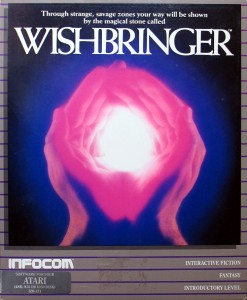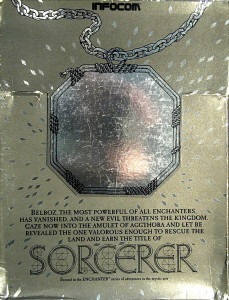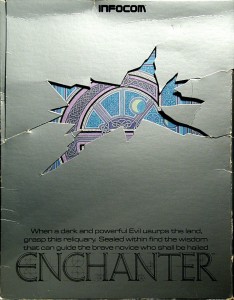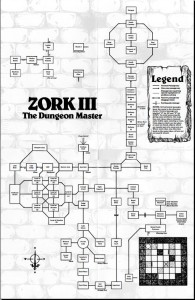Brian Moriarty was the first of a second wave of Infocom authors from very different and more diverse backgrounds than the original Imps. Their fresh perspectives would be a welcome addition during the latter half of the company’s history. Some of the second wave all but stumbled through the doors of Infocom, but not Moriarty — not at all Moriarty. His arrival as an Imp in September of 1984 marked the fruition of a calculated “assault on Infocom” — his words, not mine — that had taken over two years to bring off.
Moriarty’s personal history is perfect for an Imp, being marked by a mix of technical and literary interests right from his grade-school years. After taking a degree in English Literature from Southeastern Massachusetts University in 1978, he found a job in a Radio Shack store, where he spent hours many days playing with the TRS-80s. He didn’t buy a computer of his own, however, until after he had become a technical writer at Bose Corporation in Framingham, Massachusetts. It was there in 1981 that a colleague brought in his new Atari 800 to show off. Moriarty succumbed to the greatest Atari marketing weapon ever devised: the classic game Star Raiders. He soon headed out to buy an Atari system of his own.
Along with the computer and Star Raiders, Moriarty also brought home a copy of Scott Adams’s Strange Odyssey. He played it and the other Scott Adams games obsessively, thinking all the while of all the ways they could be better. Then one day he spotted Infocom’s Deadline on the shelf of his local Atari dealer. From its dossier-like packaging to its remarkable parser and its comparative reams of luxurious text, it did pretty much everything he had been dreaming about. Moriarty knew in an instant what he wanted to do, and where he wanted to do it. How great to learn that Infocom was located right there in the Boston area; that, anyway, was one problem less to deal with. Still, Infocom was a tiny, insular company at this point, and weren’t exactly accepting resumes from eager Atari enthusiasts who’d never designed an actual game before.
So Moriarty put Infocom in his long-range planning folder and went for the time being somewhere almost as cool. Back at Radio Shack, he’d worked with a fellow named Lee Pappas, whom he’d been surprised to rediscover behind the counter of the local Atari dealer when he’d gone to buy his 800 system. Pappas and a friend had by then already started a little newsletter, A.N.A.L.O.G. (“Atari Newsletter and Lots of Games”). By the end of 1982 it had turned into a full-fledged glossy magazine. Pappas asked Moriarty, who’d already been a regular contributor for some months, if he’d like to come work full-time for him. Moriarty said yes, leaving his safe, comfortable job at Bose behind; it was “the best career move I ever made.”
A.N.A.L.O.G. was a special place, a beloved institution within and chronicler of the Atari 8-bit community in much the same way that Softalk was of the Apple II scene. Their articles were just a little bit more thoughtful, their type-in programs a little bit better, their reviews a little bit more honest than was the norm at other magazines. Moriarty, a graceful writer as well as a superb Atari hacker, contributed to all those aspects by writing articles and reviews and programs. Life there was pretty good: “It was a small group of nerdy guys in their 20s who loved computer games, ate the same junk foods, and went to see the same science-fiction movies together.”
Still, Moriarty didn’t forget his ultimate goal. Having advanced one step by getting himself employed in the same general industry as Infocom, he set about writing his first adventure game to prove his mettle to anyone — Infocom, perhaps? — who might be paying attention. Adventure in the Fifth Dimension appeared in A.N.A.L.O.G.‘s April/May 1983 issue. A necessarily primitive effort written mostly in BASIC and running in 16 K, it nevertheless demonstrated some traits of Moriarty’s later work by mixing a real place, Washington D.C., with fantastic and surreal elements: a group of aliens have stolen the Declaration of Independence, and it’s up to you to track down an entrance to their alternate universe and get it back. A year later, Moriarty continued his campaign with another, more refined adventure written entirely in assembly language. Crash Dive! pits the player against a mutineer aboard a nuclear submarine, a scenario much more complex and plot-heavy than the typical magazine-type-in treasure hunt. It even included a set of Infocom-style feelies, albeit only via a photograph in the magazine.
With two games under his belt, Moriarty applied for a position as a game designer at Infocom, but his resume came right back to him. Then a colleague showed him a posting he’d spotted on the online service CompuServe. It was from Dan Horn, manager of Infocom’s Micro Group, looking for an expert 6502 hacker to work on Z-Machine interpreters. It took Moriarty about “45 seconds” to answer. Horn liked what he saw of Moriarty, and in early 1984 the latter started working for the former in the building where the magic happened. His first project involved, as chance would have it, another submarine-themed game: he modified the Atari 8-bit, Commodore 64, and Apple II interpreters to support the sonar display in Seastalker. Later he wrote complete new interpreters for the Radio Shack Color Computer and the ill-fated Commodore Plus/4.
He was tantalizingly close to his goal. Having broken through the outer gates, he just needed to find a way into the inner keep of the Imps themselves. He took to telling Berlyn, Blank, Lebling, and the rest about his ambition every chance he got, while also sharing with them his big idea for a game: a grand “historical fantasy” that would deal with no less weighty a subject than the history of atomic weapons and their implications for humanity. It seemed the perfect subject for the zeitgeist of 1984, when the Cold War was going through its last really dangerous phase and millions of schoolchildren were still walking around with souls seared by the previous year’s broadcast of The Day After.
Moriarty got his shot at the inner circle when a certain pop-science writer whom Infocom had hired to write a game was allegedly found curled up beneath his desk in a little ball of misery, undone by the thorny syntax of ZIL. This moment marks the end of Marc Blank’s dream of being able to hire professional writers off the street, set them down with a terminal and a stack of manuals, and wait for the games to come gushing forth. From now on the games would be written by people already immersed in Infocom’s technology; the few outside collaborations to come would be just that, collaborations, with established programmers inside Infocom doing the actual coding.
That new philosophy was great news for a fellow like Brian Moriarty, skilled coder that he was. The Imps decided to reward his persistence and passion and give him a shot. Only thing was, they weren’t so sure about the big historical fantasy, at least not for a first game. What they really had in mind was a made-to-order game to fill a glaring gap in their product matrix: a gentle, modestly sized game to introduce newcomers to interactive fiction — an “Introductory”-level work. And it should preferably be a Zorkian fantasy, because that’s what sold best and what most people still thought of when they thought of Infocom. None of the current Imps were all that excited about such a project. Would Moriarty be interested? He wasn’t about to split hairs over theme or genre or anything else after dreaming of reaching this point for so long; he answered with a resounding “Absolutely!” And so Brian Moriarty became an Imp at last — to no small consternation from Dan Horn, who’d thought Moriarty had come to Infocom to do “great work for me.”
It’s kind of surprising that it took Infocom this long to perceive the need for a game like the one that Moriarty would now be taking on as his first assignment. Their original matrix had offered only games for children — “Interactive Fiction Junior” — below the “Standard” level. Considering that even the hard-as-nails Hitchhiker’s Guide to the Galaxy was labelled “Standard,” the leap from “Junior” to “Standard” could be a daunting one indeed. Clearly there was room for a work more suitable for adult novices, one that didn’t condescend in the way that Seastalker, solid as it is on its own terms, might be perceived to do. Infocom had now decided to make just such a game at last — although, oddly, the problematic conflations continued. Rather than simply add a fifth difficulty level to the matrix, they decided to dispense with the “Junior” category entirely, relabeling Seastalker an “Introductory” game. This might have made existing print materials easier to modify, but it lost track entirely of Seastalker‘s original target demographic. Infocom claimed in The New Zork Times that “adults didn’t want a kid’s game; in fact, kids didn’t want a kid’s game.” Which rather belied the claim in the same article that Seastalker had been a “success,” but there you go.
Moriarty was a thoughtful guy with a bit of a bookish demeanor, so much so that his inevitable nickname of “Professor” actually suited him really well. Now he started thinking about how he could make an introductory game that wouldn’t be too condescending or trivial to the Infocom faithful who would hopefully also buy it. He soon hit upon the idea of including a magic MacGuffin which would allow alternate, simpler solutions to many puzzles at a cost to the score — literally a Wishbringer. The hardcore could eschew its use from the start and have a pretty satisfying experience; beginners could, after the satisfaction and affirmation of solving the game the easy way, go back and play again the hard way to try to get a better score. It was brilliant, as was the choice not to make using the Wishbringer just a “solve this puzzle” button but rather an intriguing little puzzle nexus in its own right. First the player would have to find it; then she would have to apply it correctly by wishing for “rain,” “advice,” “flight,” “darkness,” “foresight,” “luck,” or “freedom” whilst having the proper material components for the spell on hand, a perfect primer for the spellcasting system in the Enchanter trilogy. The wishes would, like in any good fairy tale, be limited to one of each type. So, even this route to victory would be easier but still in its own way a challenge.
At first Moriarty thought of making Wishbringer a magic ring, but what with The Lord of the Rings and a thousand knock-offs thereof that felt too clichéd. Anyway, he wanted to include it in the box as a feelie, and, cost concerns being what they were, that meant the ring would have to be a gaudy plastic thing like those ones bubble-gum machines sometimes dispensed in lieu of a gumball. Then he hit upon the idea of making Wishbringer a stone — “The Magick Stone of Dreams.” Maybe they could make the one in the package glow in the dark to give it that proper aura and distract from its plasticness? Marketing said it was feasible, and so the die (or stone) was cast. Thus did Wishbringer become the first and only Infocom game to be literally designed around a feelie. Moriarty spent some nine months — amidst all of the Hitchhiker’s and Cornerstone excitement, the high-water mark that was Christmas 1984, an office move, and the dawning of the realization that the company was suddenly in big, big trouble — learning the vagaries of ZIL and writing Wishbringer.
For all that it’s a much subtler work lacking the “Gee whiz!” quality of Seastalker, Wishbringer does feel like a classic piece of children’s literature. It casts you as a postal carrier in the quietly idyllic village of Festeron, which is apparently located in the same world as Zork and shares with that series an anachronistic mixing of modernity with fantasy. (I’m sure someone has figured out a detailed historical timeline for Wishbringer‘s relation to Zork as well as geography and all the rest, but as usual with that sort of thing I just can’t be bothered.) You dream of adventure — in fact, you’re interrupted in the middle of such a daydream as the game begins — but you’re just a mail carrier with a demanding boss. Said boss, Mr. Crisp, gives you a letter to deliver to the old woman who is proprietor of Ye Olde Magick Shoppe up in the hills north of town. On your way there you should explore the town and enjoy the lovely scenery, because once you make the delivery everything changes. The letter turns out to be a ransom note for the old woman from “The Evil One,” demanding Wishbringer itself in return for the safe return of her cat: “And now, now it claims my only companion.”
"It's getting Dark outside," the old woman remarks, and you can almost hear the capital D. "Maybe you should be getting back to town."
The old woman hobbles over to the Magick Shoppe door and opens it. A concealed bell tinkles merrily.
"Keep a sharp eye out for my cat, won't you?" She speaks the words slowly and distinctly. "Bring her to me if you find her. She's black as night from head to tail, except for one little white spot... right HERE."
The old woman touches the middle of your forehead with her finger. The light outside dims suddenly, like a cloud passing over the sun.
So, Wishbringer is ultimately just a hunt for a lost cat, a quest I can heartily get behind. But as soon as you step outside you realize that everything has changed. The scenery becomes a darker, more surreal riot reminiscent in places of Mindwheel. Mailboxes have become sentient (and sometimes carnivorous); Mr. Crisp has turned into the town’s petty dictator; a pet poodle has turned into a vicious hellhound. The game flirts with vaguely fascistic imagery, as with the giant Boot Patrols that march around the town enforcing its nightly curfew. (This does lead to one glaring continuity flaw: why is the cinema still open if the whole city is under curfew?) There’s a creepy dread and a creepy allure to exploring the changed town, a reminder that, as the Brothers Grimm taught us long ago, ostensible children’s literature doesn’t necessarily mean all sunshine and lollypops.
Like so much of Roberta Williams’s work, Wishbringer plays with fairy-tale tropes. But Moriarty is a much better, more original writer than Williams, not to mention a more controlled one. (Witness the way that the opening text of Wishbringer foreshadows the climax, a literary technique unlikely to even occur to Williams.) Rather than appropriate characters and situations whole cloth, he nails the feeling, balancing sweetness and whimsy with an undercurrent of darkness and menace that soon becomes an overcurrent when day turns to night and the big Change happens. The closest analogue I can offer for the world of Wishbringer is indeed the Brothers Grimm — but perhaps also, crazy as this is going to sound, Mr. Rogers’s Neighborhood of Make-Believe. Wishbringer has that same mixing of playfulness with a certain gravitas. There’s even some talking platypuses, one of very few examples of direct borrowing from Moriarty’s inspirations.
The other examples almost all come from Zork, including a great cameo from the good old white house and mailbox. And of course every Zork game has to have grues somewhere. The grues’ refrigerator light is my favorite gag in the whole game; it still makes me chuckle every time I think about it.
You have stumbled into the nesting place of a family of grues. Congratulations. Few indeed are the adventurers who have entered a grue's nest and lived as long as you have.
Everything is littered with rusty swords of elvish workmanship, piles of bones and other debris. A closed refrigerator stands in one corner of the nest, and something... a small, dangerous-looking little beast... is curled up in the other corner.
The only exit is to the west. Hope you survive long enough to use it.
Snoring fitfully, the little beast turns away from the light of the small stone and faces the wall.
>open refrigerator
A light inside the refrigerator goes out as you open it.
Opening the refrigerator reveals a bottle and an earthworm.
The little beast is stirring restlessly. It looks as if it's about to wake up!
>close refrigerator
A light inside the refrigerator comes on as you close it.
Indeed, while Moriarty is generally thought of as Infocom’s “serious” author on the exclusive basis of his second game Trinity, Wishbringer is full of such funny bits.
Wishbringer is very solvable, but doing so is not trivial even if you let yourself use the stone; this is of course just as Moriarty intended it. You may not even find the stone until a good third or more of the way through the game, and it definitely won’t help you with everything thereafter. Played without using the stone, I’m not sure that Wishbringer is really all that much easier than the average mid-period Infocom game at all. The most objectionable aspects for the modern player as well as the most surprising to find in an “Introductory” game are the hard time limits; you’re almost certain to need to restart a few times to fully explore Festeron before the Change and still deliver the letter in time, and you may need a few restores to get everything you need to done after the Change. An inventory limit also sometimes complicates matters; Infocom had been slowly losing interest in this sort of purely logistical problem for years, but Wishbringer demonstrates that even in an introductory game they weren’t quite there yet. Still, those are design sins worth forgiving in light of Wishbringer‘s charms — assuming you think them sins at all. Like the determination to make you work a bit for a solution even if you use the stone, they could be seen as a good thing. Wishbringer, we should remember, was meant to serve as an introduction to Infocom’s catalog as a whole, in which players would find plenty of other timers and inventory limits and puzzles that refuse to just disappear in a poof of magic. Wishbringer‘s refusal to trivialize its purpose is really quite admirable; there’s even a (thankfully painless) pseudo-maze.
Wishbringer was released in June of 1985, six full months after Infocom’s previous game Suspect. That gap would turn out to be the longest of Infocom’s productive middle years, and had left many fans worried about the company’s future and whether Cornerstone meant the end of games. Infocom’s idea that there were people potentially interested in interactive fiction but eager for a gentler version of the form turned out to be correct. Wishbringer turned into one of Infocom’s last genuine hits; Billboard software charts from the second half of 1985 show it and Hitchhiker’s regularly ensconced together inside the Top 20 or even Top 10, marking the last time Infocom would have a significant presence there. It sold almost 75,000 copies in its first six months, with a lifetime total perhaps as high as 150,000. To the best of my reckoning it stands as about Infocom’s fifth best-selling game overall.
Sales figures aside, Wishbringer‘s “Introductory” tag and its gentle, unassuming personality can make it an easy game amongst the Infocom canon to dismiss or overlook. That would be a shame to do, however; it’s one of the most likeable games Infocom ever did. While not one of Infocom’s more thematically or formally groundbreaking games and thus not one of their more discussed, it continues to be enjoyed by just about everyone who plays it. It’s the sort of game that may not come up that often when you ask people about their very favorites from Infocom, but mention it to any Infocom fan and you’ll almost always get back an “Oh, yes. I really liked that one.” Rather than bury its light charm under yet more leaden pontification, I’ll just suggest you play it if you haven’t already.
(Jason Scott’s interviews for Get Lamp informed much of this article. Interviews with Moriarty of various vintages can be found online at The IF Archive, Adventura CIA, Electron Dance, and Halcyon Days. Also useful was Moriarty’s “self-interview” in the January/February 1986 AmigaWorld; his picture above comes from that article. Adventure in the Fifth Dimension was published in the April/May 1983 A.N.A.L.O.G.; Crash Dive! in the May 1984 A.N.A.L.O.G., the last to which Moriarty contributed.)
















